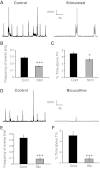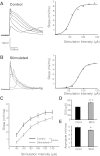Chronic electrical stimulation homeostatically decreases spontaneous activity, but paradoxically increases evoked network activity
- PMID: 23324317
- PMCID: PMC3628006
- DOI: 10.1152/jn.00612.2012
Chronic electrical stimulation homeostatically decreases spontaneous activity, but paradoxically increases evoked network activity
Abstract
Neural dynamics generated within cortical networks play a fundamental role in brain function. However, the learning rules that allow recurrent networks to generate functional dynamic regimes, and the degree to which these regimes are themselves plastic, are not known. In this study we examined plasticity of network dynamics in cortical organotypic slices in response to chronic changes in activity. Studies have typically manipulated network activity pharmacologically; we used chronic electrical stimulation to increase activity in in vitro cortical circuits in a more physiological manner. Slices were stimulated with "implanted" electrodes for 4 days. Chronic electrical stimulation or treatment with bicuculline decreased spontaneous activity as predicted by homeostatic learning rules. Paradoxically, however, whereas bicuculline decreased evoked network activity, chronic stimulation actually increased the likelihood that evoked stimulation elicited polysynaptic activity, despite a decrease in evoked monosynaptic strength. Furthermore, there was an inverse correlation between spontaneous and evoked activity, suggesting a homeostatic tradeoff between spontaneous and evoked activity. Within-slice experiments revealed that cells close to the stimulated electrode exhibited more evoked polysynaptic activity and less spontaneous activity than cells close to a control electrode. Collectively, our results establish that chronic stimulation changes the dynamic regimes of networks. In vitro studies of homeostatic plasticity typically lack any external input, and thus neurons must rely on "spontaneous" activity to reach homeostatic "set points." However, in the presence of external input we propose that homeostatic learning rules seem to shift networks from spontaneous to evoked regimes.
Figures








Similar articles
-
Limbic gamma rhythms. II. Synaptic and intrinsic mechanisms underlying spike doublets in oscillating subicular neurons.J Neurophysiol. 1998 Jul;80(1):162-71. doi: 10.1152/jn.1998.80.1.162. J Neurophysiol. 1998. PMID: 9658038
-
Electrophysiological mapping of GABAA receptor-mediated inhibition in adult rat somatosensory cortex.J Neurophysiol. 1996 Apr;75(4):1589-600. doi: 10.1152/jn.1996.75.4.1589. J Neurophysiol. 1996. PMID: 8727398
-
Synaptic input from CA3 pyramidal cells to dentate basket cells in rat hippocampus.J Physiol. 1995 Aug 15;487(1):125-46. doi: 10.1113/jphysiol.1995.sp020866. J Physiol. 1995. PMID: 7473243 Free PMC article.
-
Removal of GABAergic inhibition alters subthreshold input in neurons in forepaw barrel subfield (FBS) in rat first somatosensory cortex (SI) after digit stimulation.Exp Brain Res. 2002 Aug;145(4):411-28. doi: 10.1007/s00221-002-1124-7. Epub 2002 Jul 3. Exp Brain Res. 2002. PMID: 12172653
-
Brain mechanisms of mental processing: from evoked and spontaneous brain activities to enactive brain activity.Psychoradiology. 2023 Jun 30;3:kkad010. doi: 10.1093/psyrad/kkad010. eCollection 2023. Psychoradiology. 2023. PMID: 38666106 Free PMC article. Review.
Cited by
-
Familiarity Detection and Memory Consolidation in Cortical Assemblies.eNeuro. 2020 May 11;7(3):ENEURO.0006-19.2020. doi: 10.1523/ENEURO.0006-19.2020. Print 2020 May/Jun. eNeuro. 2020. PMID: 32122957 Free PMC article.
-
Understanding the Impact of Neural Variations and Random Connections on Inference.Front Comput Neurosci. 2021 Jun 7;15:612937. doi: 10.3389/fncom.2021.612937. eCollection 2021. Front Comput Neurosci. 2021. PMID: 34163343 Free PMC article.
-
Enhancing excitatory activity of somatosensory cortex alleviates neuropathic pain through regulating homeostatic plasticity.Sci Rep. 2017 Oct 6;7(1):12743. doi: 10.1038/s41598-017-12972-6. Sci Rep. 2017. PMID: 28986567 Free PMC article.
-
Ex vivo cortical circuits learn to predict and spontaneously replay temporal patterns.Nat Commun. 2025 Apr 4;16(1):3179. doi: 10.1038/s41467-025-58013-z. Nat Commun. 2025. PMID: 40185714 Free PMC article.
-
Plasticity within non-cerebellar pathways rapidly shapes motor performance in vivo.Nat Commun. 2016 May 9;7:11238. doi: 10.1038/ncomms11238. Nat Commun. 2016. PMID: 27157829 Free PMC article.
References
Publication types
MeSH terms
Substances
Grants and funding
LinkOut - more resources
Full Text Sources
Other Literature Sources

